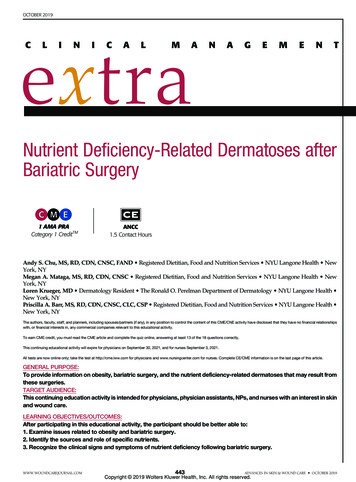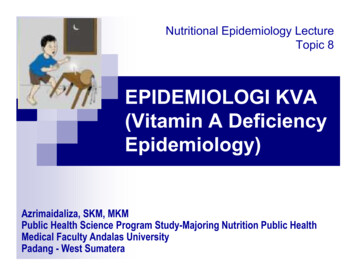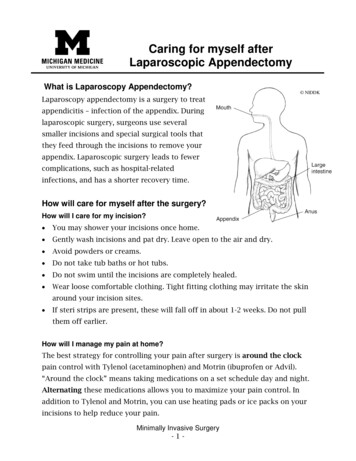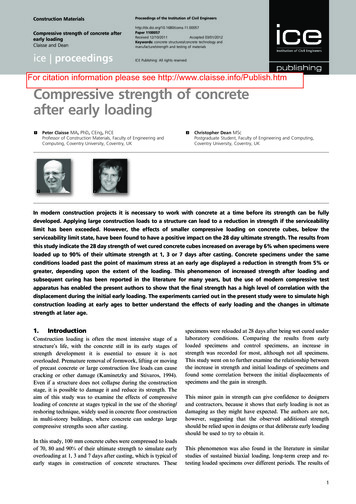
Transcription
OCTOBER 2019CLINICALMAe xtraNAGEMENTNutrient Deficiency-Related Dermatoses afterBariatric SurgeryC M E1 AMA PRACategory 1 CreditTMANCC1.5 Contact HoursAndy S. Chu, MS, RD, CDN, CNSC, FAND Registered Dietitian, Food and Nutrition Services NYU Langone Health NewYork, NYMegan A. Mataga, MS, RD, CDN, CNSC Registered Dietitian, Food and Nutrition Services NYU Langone Health NewYork, NYLoren Krueger, MD Dermatology Resident The Ronald O. Perelman Department of Dermatology NYU Langone Health New York, NYPriscilla A. Barr, MS, RD, CDN, CNSC, CLC, CSP Registered Dietitian, Food and Nutrition Services NYU Langone Health New York, NYThe authors, faculty, staff, and planners, including spouses/partners (if any), in any position to control the content of this CME/CNE activity have disclosed that they have no financial relationshipswith, or financial interests in, any commercial companies relevant to this educational activity.To earn CME credit, you must read the CME article and complete the quiz online, answering at least 13 of the 18 questions correctly.This continuing educational activity will expire for physicians on September 30, 2021, and for nurses September 3, 2021.All tests are now online only; take the test at http://cme.lww.com for physicians and www.nursingcenter.com for nurses. Complete CE/CME information is on the last page of this article.GENERAL PURPOSE:To provide information on obesity, bariatric surgery, and the nutrient deficiency-related dermatoses that may result fromthese surgeries.TARGET AUDIENCE:This continuing education activity is intended for physicians, physician assistants, NPs, and nurses with an interest in skinand wound care.LEARNING OBJECTIVES/OUTCOMES:After participating in this educational activity, the participant should be better able to:1. Examine issues related to obesity and bariatric surgery.2. Identify the sources and role of specific nutrients.3. Recognize the clinical signs and symptoms of nutrient deficiency following bariatric surgery.WWW.WOUNDCAREJOURNAL.COM443ADVANCES IN SKIN & WOUND CARE OCTOBER 2019Copyright 2019 Wolters Kluwer Health, Inc. All rights reserved.
Energy balance has always been the center stage of weightmanagement. Unhealthy dietary choices, such as excessive consumption of added sugar, processed grains, processed meats,saturated fat, trans fat, and calories, and poor intake of fruitsand vegetables can increase the risk of being overweight andobese.7Sedentary lifestyle related to excessive screen time, includingtelevision, computer, video game, internet use, and social mediahas been associated with elevated BMI.7 High amounts of screentime, especially television watching, is a strong obesity risk factorbecause it displaces time for physical activity, promotes poor dietthrough exposure to food and beverage marketing, and providesmore opportunities for unhealthy snacking.8Lack of sleep is another emerging risk factor for obesity. Studies have demonstrated a high BMI in people who are deprived ofsleep.9 It is hypothesized that sleep deprivation could increasethe risk of obesity by reducing energy expenditure related tobeing too tired to exercise, increasing consumption of calories because those who are sleep-deprived are awake longer and therefore have more opportunities to eat, and disrupting the hormonesthat control appetite and hunger.7,8Acute and chronic stress related to major life changes, work orschool, difficult relationships, financial problems, children andfamily, and low self-esteem alter the brain and its production ofhormones that affect appetite and eating behavior, resulting inunder- or overeating.7,10Built and social environmental factors can increase the riskof being overweight and obese.7 Individuals make decisionsbased on their surrounding environments. Environmental factors play a significant role in people’s dietary and activity preferences.8 Food deserts are often situated in neighborhoodswith low socioeconomic status, and companies aggressivelymarket the unhealthy food and sugary drinks sold in thesefood deserts. A lack of access to recreational facilities forexercising; safe ways to walk around the neighborhood; andaccess to healthy food and snacks in school, in the workplace,or in the convenience store all affect quality of life and ahealthy weight. 7,8Studies have suggested that individuals can be geneticallypredisposed to being overweight or obese. More than 50obesity-related genes have been identified in genome-wideassociation studies.11 However, most of these genes accountfor only small effects on obesity.11 Although obesity can runin families, an increase in BMI was relatively small betweenindividuals with high and low genetic risk of obesity scores.The epidemic of obesity over the past several decades appears to be beyond genetics.4,12A consistent combination of healthy dietary pattern, regularphysical activity, adequate sleep, appropriate stress management,and healthy environment is important for substantial healthABSTRACTObesity is a global epidemic that increases the risk of weight-relatedcomorbidities in modern society. It is complex, multifactorial, andlargely preventable. Noninvasive treatments for obesity include diet,exercise, and medication. However, bariatric surgeries arebecoming popular procedures for those who do not achievesuccess with noninvasive weight management treatment. Bariatricsurgeries often result in dietary restriction and/or malabsorption,which lead to drastic weight loss. Individuals who had bariatricsurgeries need lifelong follow-up and monitoring to ensureadequate intake of nutrients. Nutrient deficiencies can ensue whenlong-term vitamin and mineral supplementation is not followed.Severe nutrient deficiencies may lead to dermatoses that can becorrected by nutrient repletion and careful monitoring. A case reportof nutrient deficiency-related dermatoses is followed by a review ofobesity and its treatments with a focus on bariatric surgeries.KEYWORDS: bariatric surgery, dermatitis, obesity,nutrient deficiency, nutrition, supplementationADV SKIN WOUND CARE 2019;32:443–55.INTRODUCTIONObesity is a complex, multifactorial, and largely preventable disease. In general, obesity is defined as excess body weight forheight. The World Health Organization and the National Institutes of Health specifically define obesity as having a body massindex (BMI) of 30.0 kg/m2 or higher.1 It is further subdivided intoclass 1 (BMI of 30.0–34.9 kg/m2), class 2 (BMI of 35.0–39.9 kg/m2),and class 3 (BMI of 40.0 kg/m2 or higher) categories.It is estimated that more than one-third of American adults areobese and one-third of adults in the world is overweight or obese.1,2Obesity is a global epidemic that increases weight-related healthrisk and may even pose a national security threat.2,3 Obesity is aleading cause of heart disease, stroke, type 2 diabetes, sometypes of cancers, and premature death.1,4 For the first time in history, today’s youth may have a shorter life expectancy than theirparents because of obesity, despite advances in technology.5 Further, Americans with obesity spent 1,429 more on medical carethan people with normal weight in 2006.6 It is estimated that annual healthcare costs attributable to obesity total 190 billion ayear, about 21% of healthcare expenditures in the US.4The causes of obesity are multifactorial, and risk factors aredivided into those that are modifiable or nonmodifiable. Modifiable risk factors include unhealthy lifestyle habits and environments. Nonmodifiable risk factors include age, family historyand genetics, race and ethnicity, and sex.7 See Table 1 for all therisk factors of obesity.ADVANCES IN SKIN & WOUND CARE VOL. 32 NO. 10444Copyright 2019 Wolters Kluwer Health, Inc. All rights reserved.WWW.WOUNDCAREJOURNAL.COM
Table 1.RISK FACTORS OF OBESITYLifestyleEnvironmentGenetics Excessive caloric intake Excessive empty calories Low physical activity Sedentary lifestyle Lack of sleep Chronic stress Increased screen time Lack of access to physical activity Food deserts Viruses Microbiota “Obesogens” Poverty “Impulse marketing” by the food industry Age Family history Race and ethnicity Gender Poor prenatal dietary choices and lifestylebenefits and prevention of weight-related chronic diseases suchas type 2 diabetes and heart disease.13However, some studies suggest acrochordons may be moreclosely linked to insulin resistance than obesity.20Hirsutism refers to terminal hair growth in areas that typically haveminimal or vellus-type hairs. Terminal hair growth of the upper lip,temples, jawline, and chin is common. Hirsutism is thought tobe a sign of hyperandrogenism, and facial hirsutism has been associated with obesity.21 Additional signs of hyperandrogenism, likelyfrom excessive androgen production from fatty tissue, include androgenic alopecia, acne, and hidradenitis suppurativa.Psoriasis is an inflammatory skin condition that has been associated with cardiovascular disease, including dyslipidemia anddiabetes mellitus.22 Although psoriasis can occur in anyone, itis more common in individuals with obesity. Psoriasis presentswith erythematous, scaly plaques and can be associated with nailchanges and joint disease.Obesity is a risk factor for hidradenitis suppurativa. Hidradenitissuppurativa is a devastating inflammatory disorder of the apocrineglands that presents with erythematous, painful papulonodulesand sinus tracts. These lesions develop commonly in the axillae,below the breasts, and in the groin and buttocks.23 Hurley stagingis frequently used to characterize the clinical signs of severity.OBESITY-RELATED SKIN DISORDERSObesity is associated with changes in collagen structure andfunction, altered skin barrier function, abnormal sebaceous glandsand sebum production, impaired microcirculation and microcirculation, increased skin infection, poor wound healing, andgreater transepidermal water loss.14,15 In addition, many patientswith obesity experience acne, hirsutism, and androgenetic alopecia because of hyperandrogenism related to insulin resistanceand hyperinsulinemia.14,15 Moreover, it is believed that certaindermatologic disorders such as psoriasis, keratosis pilaris, seborrheicdermatitis, lichen sclerosis, acanthosis nigricans, acrochordons,striae distensae, adiposis dolorosa, scleroderma, livedo reticularis,and granular parakeratosis are more common in individualswho are obese.14,15The cutaneous manifestations of obesity vary widely andinclude benign neoplasms and inflammatory skin disorders.Although recognizing these cutaneous findings is not requiredto establish a diagnosis of obesity or metabolic syndrome,these may represent downstream effects.16 The following disorders do not constitute an exhaustive list, but include somekey dermatoses associated with obesity.Acanthosis nigricans presents with hyperpigmented, thickenedplaques commonly on the neck and intertriginous areas. Theseareas are usually asymptomatic. It is a cutaneous manifestationof increased insulin and insulin-like growth factor 1 levels.14 It isproposed that keratinocytes are activated, resulting in hyperplasia,in the setting of insulin-like growth factor.17 This is the most common cutaneous finding in obesity, in up to 74% of patients.14,18Acrochordons, or skin tags, are fleshy, skin-colored, pedunculated papules that commonly occur on the neck, axillae, belowthe breasts, and in groin folds in individuals who are obese. Skintags can become irritated or painful if traumatized by clothing orjewelry. In one study of 156 patients, 38 had acrochordons, withan increased likelihood of acrochordons with increased BMI.19WWW.WOUNDCAREJOURNAL.COMWEIGHT MANAGEMENT AND ELIGIBILITY FORBARIATRIC SURGERYAccording to the National Health and Nutrition Examination Survey, 49% of American adults tried to lose weight over the course of12 months from 2013 to 2016.24 Both the World Health Organizationand the National Institutes of Health recommend modest weight lossto improve general health, including improved glycemic control, BP,and cholesterol level.25 Lifestyle modification is often the firstchoice for weight management because it is noninvasive. Diet,exercise, and behavior therapy reduce exposure to food, decreasecues to eat, and strengthen dietary restraint. Lifestyle modification enhances the external environment to help patients reducetheir caloric intake and increase energy expenditure.25Currently, a number of drugs are approved by the FDA for weightloss.26 Pharmacotherapy is often recommended for people who445ADVANCES IN SKIN & WOUND CARE OCTOBER 2019Copyright 2019 Wolters Kluwer Health, Inc. All rights reserved.
have a BMI 30 kg/m2 or higher, or BMI 27 kg/m2 or higher with otherrisk factors, or diseases who cannot lose weight with lifestyle modifications alone.25,26 Pharmacotherapy reduces hunger, lowers food preoccupation, increases satiety, and decreases nutrient absorption.27Similar to other chronic diseases such as heart failure, hypertension, and diabetes, obesity is often managed with a combinationof pharmacotherapy and lifestyle modification.26Making lifestyle modifications is not easy and may not be enoughto lose sufficient amounts of weight to achieve optimal health. Bariatric surgery is an alternative option for those who are unsuccessfulwith lifestyle modification and pharmacotherapy. Bariatric surgerychanges the digestive system anatomically to limit the quantity offood that can be eaten and absorbed, resulting in weight loss.28 Itis increasingly accepted and accessible to the general public.29 Infact, Medicare and many private health insurance providers nowoffer bariatric surgery coverage.29Bariatric surgery can significantly reduce weight-related healthrisks via long-term weight loss.30 In general, bariatric surgery isan option for adults with a minimum BMI of 40 kg/m2 or a BMIof 35 kg/m2 or greater coupled with a serious obesity-relatedhealth problem such as diabetes, high BP, severe sleep apnea,nonalcoholic fatty liver disease, osteoarthritis, lipid abnormalities, gastrointestinal disorders, or heart disease. Gastric bandingis an option for adults with a BMI of 30 kg/m2 or greater withone of the aforementioned obesity-related health problems.30,31Bariatric surgery is not for everyone and is not a way to avoidmaking lifestyle and dietary changes.28seem to cause decreased feelings of hunger, early satiety, andfewer calories consumed, but they result in slower weight lossthan other surgeries.Sleeve GastrectomyLaparoscopic sleeve gastrectomy (SG), or simply “the sleeve,” isa surgery that removes about 80% of the stomach.34 The remaining portion is a narrow tube that looks similar to a banana. Thissurgery is meant to aid in weight loss by simply reducing theamount of food that can be consumed. However, studies haveshown that the large impact of the sleeve on weight loss is attributable to the changes in intestinal hormones that take place afterthe surgery.35 Both of these factors can contribute to decreasedhunger, sensations of fullness, and better blood sugar control.Patients who undergo SG require lifelong vitamins and mineralsupplementation to ensure optimal nutrition. Over time, manypatients experience significant weight regain because of pouchexpansion, further alterations in gut hormone levels, lack ofnutrition follow-up, and poor dietary choices.Roux-en-Y Gastric BypassIn the world of weight loss surgery, Roux-en-Y gastric bypass isoften considered the criterion standard and has been the mostcommonly performed operation for weight loss in the US. It isa more complex procedure than AGB or SG and consists of a surgical anastomosis between the stomach and small intestine. First,the surgeon staples off the upper section of the stomach, forminga pouch usually about 30 mL in volume. Next, the first portionof the small intestine is divided, and the distal portion, calledthe Roux limb, is connected to the small stomach pouch. Finally,the top portion of the small intestine is connected to a portionfurther down so that stomach acid and other digestive enzymescan act on the food. This procedure is both restrictive and malabsorptive and results in significant long-term weight loss. Thepouch restricts the amount of food consumed, and the reroutingof food past a portion of the small intestine limits the absorptionof calories as well as some vitamins and minerals. In addition,this anatomical change causes hormonal adjustments, which leadto alterations in feelings of fullness and hunger.35 Complicationssuch as gastric distress and discomfort (dumping syndrome), vitaminand mineral deficiencies, and food intolerances can occur after thissurgery.36 These can be managed with dietary compliance andlifelong supplementation. Although Roux-en-Y gastric bypassis a more complicated surgery, some studies show that amountand rate of weight loss are similar to those achieved with SG.37,38COMMON TYPES OF BARIATRIC SURGERIESThe options for bariatric surgery continue to grow. It is estimatedthat 228,000 bariatric procedures were performed in the US in 2017,compared with 158,000 in 2011. The gastric sleeve was the mostpopular surgery, followed by Roux-en-Y gastric bypass.32 Bariatricsurgeries can be classified as restrictive, malabsorptive, or a combination of both.33 These types of surgeries may also cause hormonal alterations and require dietary changes and exercise toensure healthy, long-term, sustainable weight loss. See Figure 1for an illustration of the four common bariatric surgeries.Laparoscopic Adjustable Gastric BandingAdjustable gastric band (AGB) is a laparoscopic procedure thatplaces an inflatable band around the upper portion of the stomach.34 This creates a very small reservoir above the band for holding food, while the rest of the stomach remains intact below theband. The AGB is thought to aid in weight loss because smallerportions are needed to satisfy hunger and cause fullness. Theband can be adjusted to create different-sized openings betweenthe pouch and the rest of the stomach. This procedure is solelyrestrictive; there is no malabsorption of nutrients, and digestionand absorption continue as normal. Ultimately, AGB proceduresADVANCES IN SKIN & WOUND CARE VOL. 32 NO. 10Duodenal Switch with Biliopancreatic DiversionSimilar to Roux-en-Y gastric bypass, the biliopancreatic diversionwith duodenal switch (BPD/DS) is a two-step surgery that involves a reduction of the stomach and rerouting of the small446Copyright 2019 Wolters Kluwer Health, Inc. All rights reserved.WWW.WOUNDCAREJOURNAL.COM
intestine.34 However, in the BPD/DS, food ultimately bypasses amuch larger portion of the small intestine. First, a narrow,banana-shaped pouch is created by removing a large portion ofthe stomach. Second, the duodenum is cut very close to thegastric outlet. Next, a piece of the last part of the small intestineis connected to the stomach. Finally, the bypassed portion thatholds the digestive juices is sewn to the most distal portion, sothat the bile and pancreatic enzymes such as lipase and proteasecan mix with the food. This surgery is considered restrictive andmalabsorptive, but over time, the stomach can stretch so thatthe patient can eat normal-sized meals. Therefore, the longterm effect of this surgery is primarily malabsorptive because ofthe significantly diminished capacity to absorb protein and fat.Similar complications can result from the BPD/DS as in theRoux-en-Y. This surgery also results in significant weight lossrequiring dietary modifications and supplementation.Figure 1.COMMON TYPES OF BARIATRIC SURGERYBARIATRIC SUGERY-RELATEDDERMATOLOGIC DISORDERSAn individual with obesity is not necessarily well nourished.Many are already suffering from nutrient deficiencies that canbe exacerbated by bariatric surgery given its nature of food restriction and/or nutrient malabsorption.15 For example, glossitis,angular cheilitis, erythematous desquamative dermatitis, and reduced nia
Bariatric Surgery CME 1AMAPRA Category 1 CreditTM ANCC 1.5 Contact Hours Andy S.Chu,MS,RD, CDN, CNSC, FAND † RegisteredDietitian, FoodandNutrition Services † NYU Langone Health † New York, NY Megan A. Mataga, MS, RD, CDN, CNSC † Registered Dietitian, Food and Nutrition Serv











